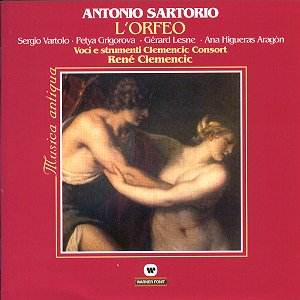Born in Venice, Sartorio composed 14 operas.
He often made the long journey from Hanover, where he held the post
of Maestro di Capella to the Duke of Brunswick, to compose and present
new operas in his native city and recruit musicians for the German court.
He is credited with introducing Italian opera to the Hanover court in
1672. Sartorio finally returned to Venice to be Maestro at St Mark’s
where he composed sacred music, albeit not as much as the renowned Coffi
might have been expected of him in that position.
Sartorio’s L’Orfeo is based on a libretto
by Aurelio Aureli (1652-1708). It was premiered in Venice during the
1672-73 carnival season. Both the text and the music are typical of
the authors, with complex sub-plots, ten scene changes, six ballets
(not included here but in the Venetian score). It is a characteristic,
but not particularly distinguished, example of Venetian opera of the
second half of the 17th Century.
Aureli transformed the myth so that Orpheus is no longer
the heroic lover prepared to travel to Hades to reclaim his beloved
Euridice, but a husband whose chief passion is jealousy, so strong that
he plots the death of his wife! Even her second death fails to move
Orpheus for long although it inspires a fully fledged lament (CD3 tk2),
after which he quickly resigns himself to living without her and, foreswearing
all womanhood, he simply disappears. This allows the invented sub-plots
to unravel to the conventional happy ending.
Sartorio’s setting of the text reflects his Venetian
background and the heritage of Monteverdi and Cavalli. However, the
recitatives, the core of Monteverdian operatic expression are replaced
by arias of which L’Orfeo contains over 50, with each of the
10 characters given opportunity to express feelings directly to the
audience in one or more monologue scenes. These scenes usually consist
of two contrasting arias separated by a passage of recitative.
The recording is based on live performances given at
the International Festival of Contemporary Music in Venice in 1979.
It represents the first revival in modern times of an opera that was
very popular in its time, even being presented as far away from Venice
as Vienna. The stage production was recorded by Italian television and,
given the circumstances, there are few extraneous noises and little
premature applause. Generally the sound is very acceptable with the
voices clear and the authentic instrument band in a realistic balance.
Given the musicological significance of the performance
it is appropriate that the music is realised by René Clemencic
and the voices and instruments of the Clemencic Consort. Specialists
in this field, with many recordings to their credit, often of public
performances, the band sound fully authentic with gut strings, lute,
viola de gamba, etc. to an accompanying harpsichord. No attribution,
or details of the instrumentation is given. Each of the 3 Acts is contained
in a separate CD.
L’Orfeo requires 10 soloists; 3 counter-tenors,
3 sopranos, 2 tenors, 1 baritone, and 1 bass. It would not be appropriate
to analyse each contribution in a work and performance such as this.
However, whilst not expecting a Schöll or Daniels as Orfeo, it
was the ungracious, thin tone of Serio Vortolo in the title role that
was my major disappointment. Elsewhere, except for a little unexpected
vibrato here and there, the performances are adequate.


